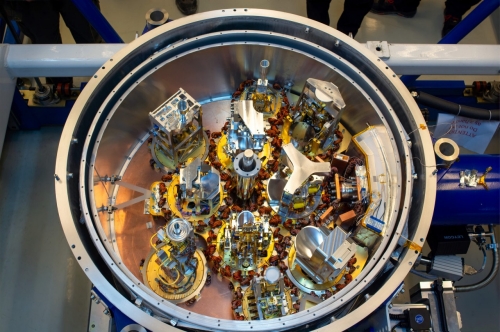An international team of astronomers and engineers at the Atacama Large Millimeter/submillimeter Array (ALMA) have made the first measurements using new receivers installed on multiple ALMA antennas. The receivers allow to observe within the final frequency range — with wavelengths between 2.6 to 4.5 millimeters (67-116 GHz) — for which it was designed. Band 2 opens a new window into our cosmic origins, allowing measurements that reveal how distant stars and galaxies form, all the way down to the origins of planets and the building blocks of life.
New Band 2 ALMA receivers that will probe our cosmic origins successfully tested

This image shows the cryostat of an ALMA antenna populated with 10 receivers for the first time. The receivers pick up the signals from outer space at specific frequency bands, covering a window from 950 to 35 GHz, and are stored in a cryostat that cools them down to temperatures as low as -269°C. The installation of the Band 2 receivers, initiated in 2023, means ALMA antennas can observe within the final frequency range (67 to 116 GHz) for which the array was designed. Credit: S. Otarola - ALMA (ESO/NAOJ/NRAO)
The first Band 2 pre-production receiver was successfully installed and tested on an ALMA antenna earlier this year. Now, a second Band 2 pre-production receiver has been installed on another ALMA antenna, enabling true interferometry: measuring the fringe pattern that results from the correlation of multiple signals from a bright astronomical object. This “first fringes” milestone means astronomers have been able to combine the signals from multiple antennas for the first time in Band 2. As further ALMA antennas are upgraded with Band 2 receivers, the amount of detail and level of sensitivity will improve, allowing for ever more precise observations of our Universe.
ALMA Band 2 will allow important measurements of the cold interstellar medium, the mixture of dust and molecular gas that exists in the space between stars and fuels star formation. As well as this, ALMA will be able to study the properties of dust and molecules in objects from planet-forming discs to far-away galaxies at a level of detail never achieved before.
Closer to home, the new receivers will enable observations of complex organic molecules in nearby galaxies, providing clues on how the conditions for life to begin are created. At the same time, Band 2 will be important for helping astronomers better understand how planets form by probing the carbon monoxide “snow line”, a region in planet-forming discs far away enough from the central stars for gas to condense.
Read more in the ALMA observatory press release.

